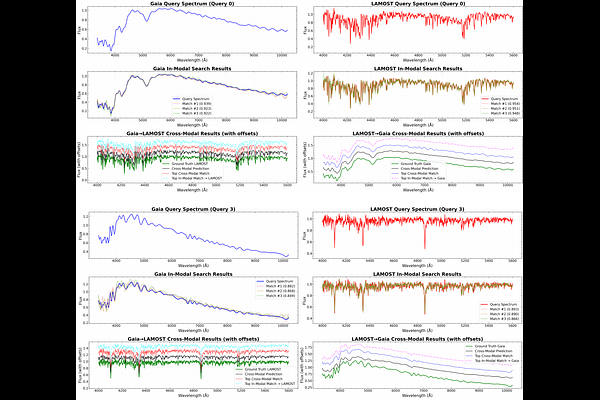SpecCLIP: Aligning and Translating Spectroscopic Measurements for Stars

SpecCLIP: Aligning and Translating Spectroscopic Measurements for Stars
Xiaosheng Zhao, Yang Huang, Guirong Xue, Xiao Kong, Jifeng Liu, Xiaoyu Tang, Timothy C. Beers, Yuan-Sen Ting, A-Li Luo
AbstractIn recent years, large language models (LLMs) have transformed natural language understanding through vast datasets and large-scale parameterization. Inspired by this success, we present SpecCLIP, a foundation model framework that extends LLM-inspired methodologies to stellar spectral analysis. Stellar spectra, akin to structured language, encode rich physical and chemical information about stars. By training foundation models on large-scale spectral datasets, our goal is to learn robust and informative embeddings that support diverse downstream applications. As a proof of concept, SpecCLIP involves pre-training on two spectral types--LAMOST low-resolution and Gaia XP--followed by contrastive alignment using the CLIP (Contrastive Language-Image Pre-training) framework, adapted to associate spectra from different instruments. This alignment is complemented by auxiliary decoders that preserve spectrum-specific information and enable translation (prediction) between spectral types, with the former achieved by maximizing mutual information between embeddings and input spectra. The result is a cross-spectrum framework enabling intrinsic calibration and flexible applications across instruments. We demonstrate that fine-tuning these models on moderate-sized labeled datasets improves adaptability to tasks such as stellar-parameter estimation and chemical-abundance determination. SpecCLIP also enhances the accuracy and precision of parameter estimates benchmarked against external survey data. Additionally, its similarity search and cross-spectrum prediction capabilities offer potential for anomaly detection. Our results suggest that contrastively trained foundation models enriched with spectrum-aware decoders can advance precision stellar spectroscopy.